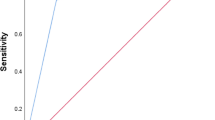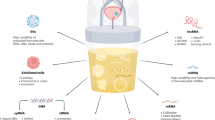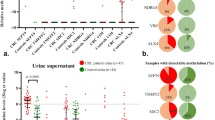Abstract
Tumour suppressor gene (TSG) methylation has been proposed as a diagnostic marker for urothelial cancer (UC). Here, we compare the frequency of urinary TSG methylation in young and elderly patients, with and without UC. Urine samples were obtained prospectively from 35 UC patients, 35 benign controls over the age of 70 years and 34 healthy volunteers under the age of 40 years. Methylation analysis was performed for eight gene promoters using quantitative methylation-specific PCR. Methylation was detected in urine DNA from all three patient groups. The highest frequencies were seen in UC patients. Significantly less methylation was present in control samples than UC cases for RASSF1a and APC (P<0.034). The ‘methylation index’ and level of methylation was highest in the UC group and lowest in the young control group. A marker panel of RASSF1a, E-cad and APC generated a sensitivity of 69%, a specificity of 60% and a diagnostic accuracy of 86%. TSG methylation is detectable in urine DNA from patients with and without bladder cancer. The frequency and extent of methylation appears to increase with age and malignancy. The lack of tumour specificity suggests that further investigation is required before this test is introduced into clinical practice.
This is a preview of subscription content, access via your institution
Access options
Subscribe to this journal
Receive 50 print issues and online access
$259.00 per year
only $5.18 per issue
Buy this article
- Purchase on Springer Link
- Instant access to full article PDF
Prices may be subject to local taxes which are calculated during checkout



Similar content being viewed by others
References
Ahuja N, Li Q, Mohan AL, Baylin SB, Issa JP . (1998). Cancer Res 58: 5489–5494.
Bornman DM, Mathew S, Alsruhe J, Herman JG, Gabrielson E . (2001). Am J Pathol 159: 831–835.
Brown FM . (2001). Urol Clin N Am 27: 25–37.
Catto JWF, Azzouzi AR, Rehman I, Feeley KM, Cross SS, Amira N et al. (2005). J Clin Oncol 23: 2903–2910.
Chan MW, Chan LW, Tang NL, Tong JH, Lo KW, Lee TL et al. (2002). Clin Cancer Res 8: 464–470.
Dulaimi E, Uzzo RG, Greenberg RE, Al-Saleem T, Cairns P . (2004). Clin Cancer Res 10: 1887–1893.
Friedrich MG, Weisenberger DJ, Cheng JC, Chandrasoma S, Siegmund KD, Gonnzalogo ML et al. (2004). Clin Cancer Res 10: 7457–7465.
Greenlee R, Hill-Harmon MB, Murray T, Thun M . (2001). CA Cancer J Clin 51: 15.
Habuchi T, Takahashi T, Kakinuma H, Wang L, Tsuchiya N, Satoh S et al. (2001). Oncogene 20: 531–537.
Harnden SV, Tokumaru Y, Westra W, Goodman S, Ahrendt SA, Yang SC et al. (2003). Clin Cancer Res 9: 370–375.
Herman JG, Baylin SB . (2003). N Engl J Med 349: 2042–2054.
Herman JG, Graff JR, Myohanen S, Nelkin BD, Baylin SB . (1996). Proc Natl Acad Sci USA 93: 9821–9826.
Issa JP . (2004). Crit Rev Oncol Hematol 32: 31–43.
Issa JP, Ottaviano YL, Celano P, Hamilton SR, Davidson NE, Baylin SB . (1994). Nat Genet 7: 536–540.
Laird PW . (2003). Nature Rev 3: 253–266.
Maruyama R, Toyooka S, Toyooka KO, Harada K, Virmani AK, Zochbauer-Muller S et al. (2001). Cancer Res 61: 8659–8663.
Molinie V, Longchampt E, Ouazana D, Lebret T . (2001). Ann Pathol 23: 306–331.
Steiner G, Schoenberg MP, Linn JF, Mao L, Sidransky D . (1997). Nat Med 3: 621–624.
Toyota M, Ahuja N, Ohe-Toyota M, Herman JG, Baylin SB, Issa JP . (1999). Proc Natl Acad Sci USA 96: 8681–8686.
Usadel H, Brabender J, Danenberg KD, Jeronimo C, Harden S, Engles J et al. (2002). Cancer Research 62: 371–375.
Acknowledgements
We thank Messrs JB Anderson, KJ Hastie, DJ Smith, PE Cuthina, DJ Rosario, J Hall, N Oakley and CR Chapple for allowing us to use their patients in this study. DY was supported by a British Urological Foundation/Cambridge Laboratory Scholarship. JWFC was supported by a Medical Research Council fellowship and a British Urological Foundation/Merck Sharpe Dohme scholarship. MM was funded by a Yorkshire Cancer Research programme. The authors thank Dr Susan Harnden for her help in establishing the QMSP assay.
Author information
Authors and Affiliations
Corresponding author
Rights and permissions
About this article
Cite this article
Yates, D., Rehman, I., Meuth, M. et al. Methylational urinalysis: a prospective study of bladder cancer patients and age stratified benign controls. Oncogene 25, 1984–1988 (2006). https://doi.org/10.1038/sj.onc.1209209
Received:
Revised:
Accepted:
Published:
Issue Date:
DOI: https://doi.org/10.1038/sj.onc.1209209
Keywords
This article is cited by
-
RETRACTED ARTICLE: Optimizing the Performance of Neural Network for Bladder Cancer Prediction and Diagnosis Using Intelligent Firefly
Arabian Journal for Science and Engineering (2023)
-
Aberrant Methylation of RASSF1A Closely Associated with HNSCC, a Meta-Analysis
Scientific Reports (2016)
-
Diagnostic markers of urothelial cancer based on DNA methylation analysis
BMC Cancer (2013)
-
DNA methylation-based biomarkers in bladder cancer
Nature Reviews Urology (2013)
-
Molecular biomarkers in urothelial carcinoma of the bladder: are we there yet?
Nature Reviews Urology (2012)



